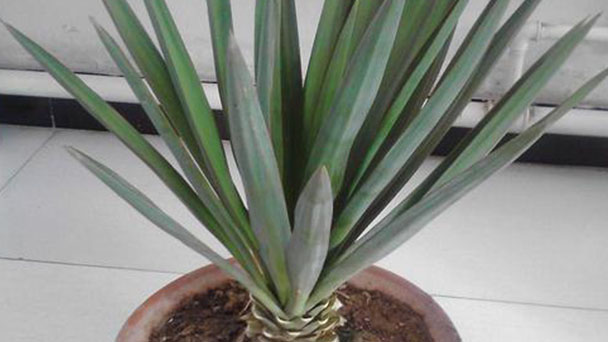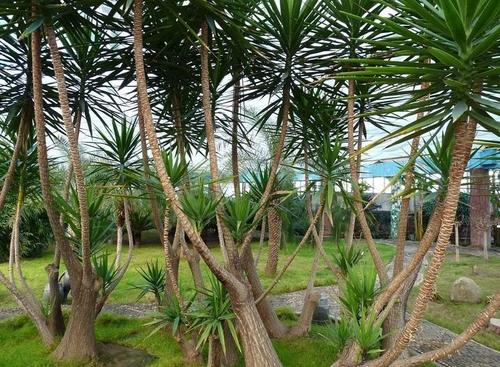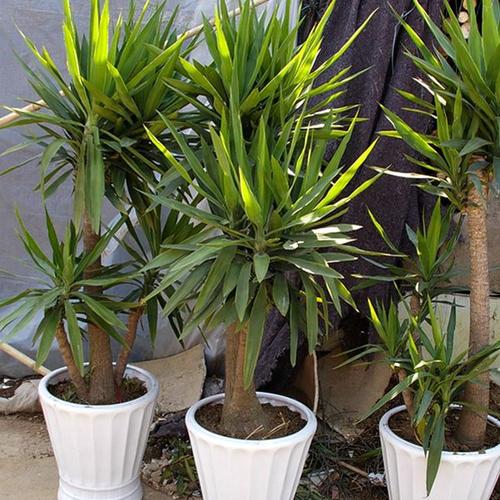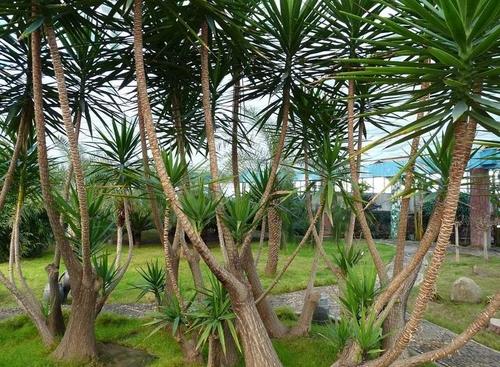Yucca elephantipes (Spineless yucca) profile
Written by Maggie
Mar 31 2021

Yucca elephantipes, commonly known as Spineless yucca, is an evergreen, wood plant. Yucca elephantipes is up to 10 meters tall in her native (warm North America) and most plants in pots are about 1 to 2 meters tall, width about 8-10 cm; Leaves are leathery, leathery, entire, green, sessile, often propagated by cuttings.
Yucca elephantipes is a leaf-watching plant in the genus Yucca in the Liliaceae. Yucca elephantipes are regular plants with strong stems and green leaves. She is very masculine and upright. It has strong adaptability, vigorous vitality, simple cultivation and management, and is a plant with strong absorption capacity to a variety of harmful gases (such as CO2, HF, Cl2, NH3, etc.). It is an ideal material for indoor and outdoor greening and decoration. Make small and medium-sized potted plants, decorate conference rooms, halls, corridors, corridors and other places, can create a solemn and serious atmosphere; Potted plantlets are also very popular on bookshelves and desks.
Yucca elephantipes picture

Yucca elephantipes characteristics
Stems
Yucca elephantipes are evergreen trees and are up to 10 meters tall in their native place of origin. Most plants in pots are about 1 to 2 meters tall. The stem is stout, erect, brown, with marked leaf marks, stem base may be enlarged to be subglobose.
Leaf
Yucca elephantipes have narrow leaves lanceolate, borne at the apex of the stem and acute at the ends, up to 100 cm long and about 8 -- 10 cm wide. Leaves are leathery, leathery, entire, green, sessile.
The ecological habits of the Yucca elephantipes
Yucca elephantipes are also resistant to shade, drought and cold. The suitable temperature for growth is 15-25 ℃, and the overwintering temperature is 0℃. The soil requirements are not strict, with loose, rich in humus loam as the best.
How to grow and care for c
1. Soil
Yucca elephantipes can be mixed with garden soil, leaf rot and river sand as culture soil. Yucca elephantipes has strong adaptability and is not strict with soil, but it grows best with loose, fertile and well-drained slightly acidic soil. When we care for yucca elephantipes, it can be mixed cultivated with loam soil with high humus content under coniferous and coniferous forest and river sand, or leaf rot soil and river sand.
2. Humidity
Growing season to keep the potting soil moist, avoid watering too much, cause water, and make the root and stem rot. When we care for Yucca elephantipes in the growing season, it is necessary to maintain a certain air humidity, such as the temperature of 20 ° C, the humidity can be about 50%, the temperature of 30 ° C, the humidity needs to be adjusted to about 70%, in order to maintain good growth momentum.
3. Fertilization
Its vitality is exuberant, to the fertilizer requirement is not high, the growth flourishing period every month applies 3-2 times liquid fertilizer namely enough.
4. Light
Yucca elephantipes require sufficient sun and are grown in full sun except for the hot summer months when appropriate shade is required.
5. Temperature
Yucca elephantipes is also resistant to shade, can adapt to the different light environment. But it should not be too overcast, otherwise long new leaves are often not easy to aging and yellow, or cause long, leaves are not healthy and drooping. Yucca elephantipes have a general growth speed and have a wide temperature requirement. The best growth temperature is between 15 and 30 ° C. When we care for Yucca elephantipes, it is best to keep above 2 ° C in winter and she is not cold resistant.
6. Repotting
It's not essential, but a good rule of thumb is to repot every two years in Spring. The plants tend to become top-heavy as most of the weight is centered at the top of the Yucca, planting in a deep heavy container will help prevent the plant from tipping over.

Is the Yucca elephantipes Poisonous?
The Yucca elephantipes are moderately poisonous to cats, dogs and people. While it can normally protect itself through the sharp edges on the leaves and hard protective bark on its trunk, if persistent pets or children damage the plant enough they'll come across the poisonous elements inside.
Yucca elephantipes propagation
1. Cutting time
Yucca elephantipes can be propagated through the growing season, but the best time to propagate is spring and autumn.
2. Select and insert
As Yucca elephantipes, she needs to choose the appropriate plant when she is doing cuttings. Usually, branches about 10cm to 30cm are cut off and stored in a cool and ventilated place to dry. We can plant Yucca elephantipes in clean river sand as soon as Yucca's wound dries up and she can root in about a month. Note that the incision should be disinfected, when inserted in the sand bed to cover about two-thirds of the sand.
3. Cottage maintenance
Yucca elephantipes requires reasonable conservation and the temperature should be kept between 20℃ and 30℃, which is conducive to the growth of roots. Cutting in the early stage of the need to avoid direct sunlight, maintain the relatively high air humidity.
Disease control of Yucca elephantipes
Yucca elephantipes anthrax
The disease mainly infects leaf tip and leaf margin, and its symptoms are similar to leaf spot. At the beginning of the disease, there are moist brown spots, sometimes pink gelatinous mucus, namely the conidia disc and conidia pile of the pathogen. After the development and diffusion, it is a semicircular or irregular oval, reddish-purple or dark brown spots.
The center is light brown or gray outstanding, and slightly hit sag, gradually expand after the disease, visible round stripes around the mark, brown, disease spot gradually atrophic dry. The patches were strewn with black granules. When coming on seriously, cause the whole leaf to become yellow wither.
Pathogen
Colletoanthrax is a fungus belonging to the subphylum hemitidum. The sexual state around the small cluster shell, belongs to the ascomycetes subphylum fungi. The conidial disc of the pathogen was born under the epidermis of the leaf. Exposed after breaking through the epidermis. Conidia disks are clustered or scattered, arranged in concentric ridges; Conidia has brown setae, conidia cylindrical, both ends blunt round, single cell, colorless.
Regularity of occurrence
The pathogen overwintered in conidia and hyphae on the residual body. In the next year, conidia were produced for primary infection and reinfection by sputtering in water. The conidia formed after the spot and reinfection led to the continuous development of the disease. High temperature, rainy season, weak growth potential, easy to disease.
Prevention and control methods
(1) Increase the application of organic fertilizer, timely drainage, to prevent moisture retention, an appropriate amount of phosphorus, potassium fertilizer.
(2) Timely pruning the sick branches and leaves and remove the sick and disabled body concentrated deep buried or burned.
(3) Conidia does not prevent and control, continuous infection of the disease, with 29% sulphur mixture 100 to 200 times the liquid or 30% suspension of basic copper sulfate 400-1000 times the liquid (application before the disease), 27% copper Nobel 500-800 times the liquid, 4% pesticide 120 aqueous agents 600 to 800 times the liquid, 25% amiseda suspension 100 to 200mg/ L 20% thiamides copper 500 to 800 times the liquid spray.
Yucca elephantipes distribution
Yucca elephantipes are native to warm parts of North America.
Yucca elephantipes uses
Yucca elephantipes are regular plants with strong stems and green leaves. Yucca elephantipes is very masculine and upright. It has strong adaptability, vigorous vitality, simple cultivation and management, and is a plant with a strong absorption capacity to a variety of harmful gases (such as CO2, HF, Cl2, NH3, etc.). Yucca elephantipes are an ideal material for indoor and outdoor greening and decoration. Make small and medium-sized potted plants, decorate conference rooms, halls, corridors, corridors and other places, can create a solemn and serious atmosphere; Potted plantlets are also very popular on bookshelves and desks.

Latest Updated
- Benefits of Bugleweed - 7 Science-backed Health Benefits
- Bugleweed Dangers & Side Effects - Is It Poisonous?
- How to Plant Evergreen Trees - What You Should Know
- When to Plant Evergreens - Grow Guide for Evergreen Trees
- 12 Wonderful Evergreen Shrubs for Your Garden
- 12 Popular Evergreen Plants with Pictures for Beginners
- When And How To Prune A Lilac Bush Like a Pro
- How to Grow & Care for Lilac Vine (Hardenbergia Violacea)
- Japanese Lilac Tree (Syringa Reticulata) Care & Propagation Guide
- Shumard Oak Pros and Cons - What to Know
Popular Articles
- Winter maintenance of Antirrhinum Majus
- How to Grow Terminalia Mantaly Tree
- How to Grow and Care for Crossostephium Chinense
- How to grow Antirrhinum Majus in spring
- Peristeria Elata (Dove Orchid) Profile: Info & Care Guide
- Underwatered Snake Plant (Sansevieria Trifasciata) - Signs And How To Fix
- How to Care for Brazilian Jasmine Plant (Mandevilla Sanderi)
- How to Grow & Care for Graptopetalum Purple Delight in Summer
- Rosa Chinensis (China Rose): Plant Growing & Care Tips
- How to Care for Baby Sun Rose (Aptenia Cordifolia)